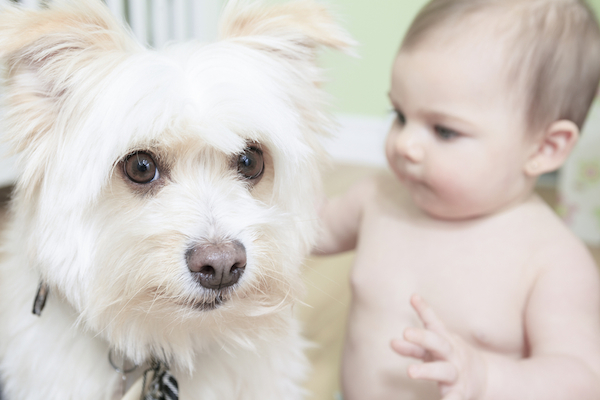Snuggled. Spoiled. Doted upon. Loved within an inch of her life. Our dog, Finley, is truly our baby. She’s been my constant companion and the apple of my husband’s eye for the past two years. But we’re about to welcome a newborn human into our home and have heard that babies and dogs can be a tricky combination.
We’ve been bracing ourselves for the transition over the past seven months, but quickly realized that crossing our fingers and hoping for the best wouldn’t be enough. Taking a proactive approach, we registered for a “bringing a baby home” class with Jeris and Eve Pugh, owners of The Martial Arfs, to learn all about introducing a new family member when a furry, four-legged one has gotten used to being the center of attention.
We soon discovered that once an infant enters the picture, everything changes. And that can be especially stressful for the family pet. An animal you might otherwise trust — much like our sweet, sensitive Finley — can become anxious or aggressive and act out in fear. In fact, many dogs you wouldn’t normally consider very threatening — from a Papillon to a Lab — have all appeared in police reports for fatally wounding children.
The thought of our cherished Vizsla attacking our new baby was upsetting of course, but also eye-opening. That’s the kind of worst-case scenario most people prefer not to think about, but there are lessons to be learned from such incidents. Here are our 20 takeaways about mixing babies and dogs:
The 20 Tips for Introducing Babies & Dogs
1. Bring your dog to the vet
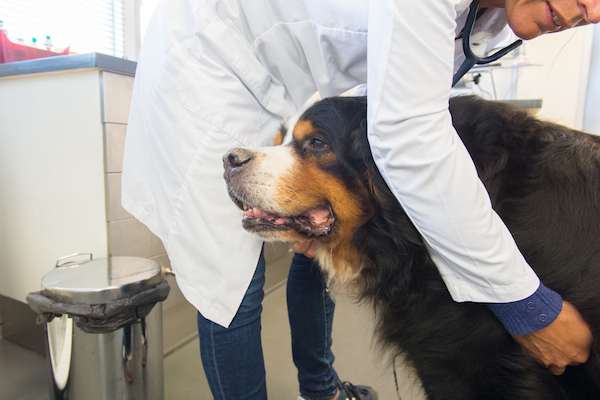
Jeris and Eve suggest requesting a full exam with bloodwork to make sure your dog isn’t experiencing any undiagnosed health problems. Managing both a newborn and a dog with a serious health issue can be especially challenging and time consuming, so it’s better to know what you’re dealing with ahead of time. Even though Finley seems relatively healthy, we’ll still get her checked about a month before the baby is due.
2. Desensitize your dog to new sights, sounds and smells
Turn on the infant swing, put up baby gates around the house and go for walks with the stroller. Play baby sounds like crying and cooing. Use baby lotion on your skin. Start carrying around a baby doll. Slowly introduce new stimuli before the baby arrives. Gradually making changes in advance will help manage your dog’s stress levels.
3. Keep all baby and dog toys separate
Better yet, teach your dog the “leave it” command. Do this well ahead of time so you’re not trying to train your pup when you have a newborn around. Finley is fairly good at leaving items alone but has a hard time giving something up once it’s in her possession — something we need to work on.
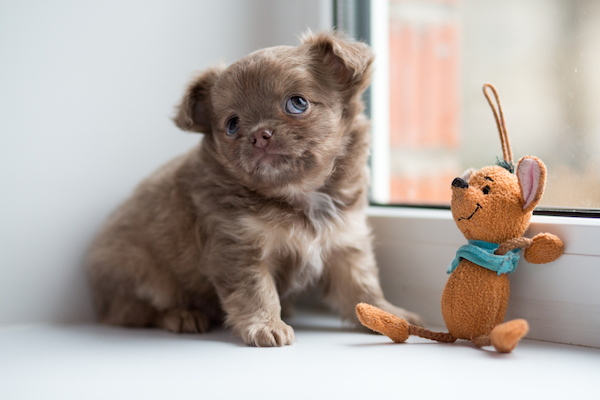
4. Let babies and dogs mix beforehand
Try to recruit nieces, nephews and children around the neighborhood for short-and-sweet visits. We’ve been walking Finley through the park and near playgrounds where kids are running around and making noise.
5. Reduce activity levels
Inevitably, your dog’s physical and mental needs are not going to be met as readily as they were pre-baby. So we’ve tested out how Finley fares with reduced activity before the baby comes. Some days she’s fine, others she’s visibly frustrated. We’re getting her accustomed to less attention and activity overall.
6. Establish a baby-free zone for your dog
This can be a crate, a corner of the house or an entire room if there’s space. For us, this is the basement where Finley is free to roam and hang out with her toys and treasures sans crying baby.
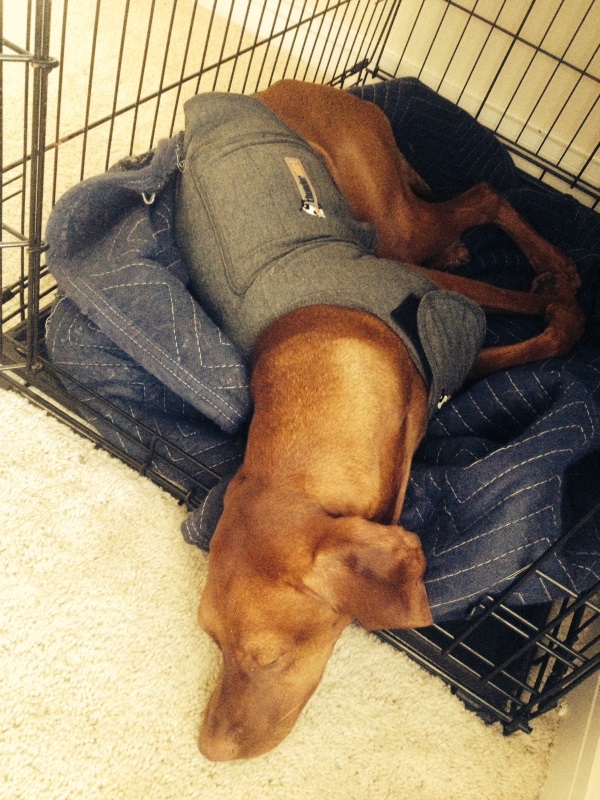
7. Practice closing your dog out of certain rooms
You may need to keep your dog out of the baby’s room, your bedroom, or any other area where your little one is sleeping, playing or eating. Getting Finley used to closed doors isn’t easy. She always wants to be part of the action, but practice makes perfect.
And now, let’s talk about making the introduction.
8. Exhaust your pooch first
When you first come home, your dog should be mentally and physically exhausted so their energy level is nice and low. Hire a dog walker or ask a close friend or relative to exercise your pooch an hour before you’re due to arrive home. For us, Finley will likely have spent a day or two at doggy daycare prior to our return home — more than enough to exhaust her.
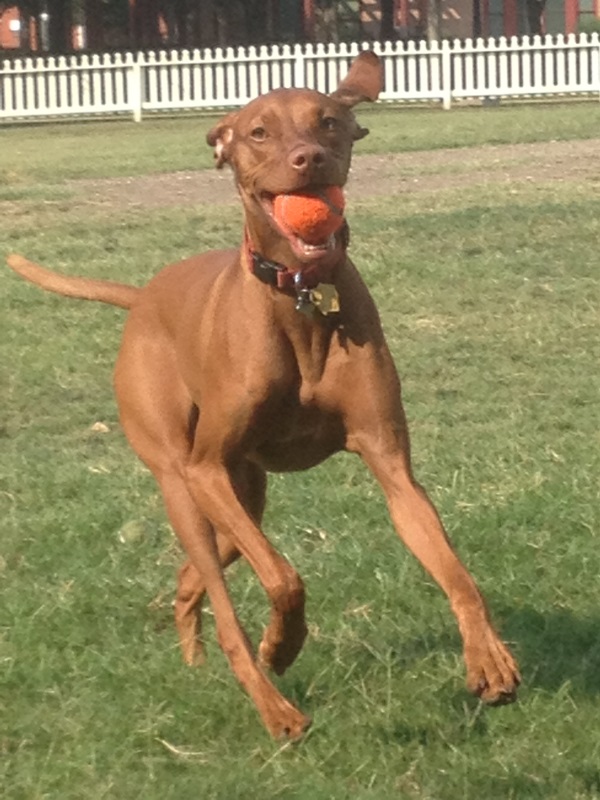
9. Don’t rush things
Many new parents are in a hurry to get the dog and baby together as one big happy family. But the introduction should be slow and gradual. Your dog can see the baby more and more often, but they shouldn’t necessarily interact on a regular basis until boundaries are set and everyone is comfortable with how things are going.
10. Invite a sniff between the dog and baby
Once your dog seems at ease with the newest family members, try offering the baby’s feet for a little sniff. Keep interactions brief and positive with plenty of treats.
11. Always know where your dog is in the house
Be aware that your dog may be able to get into the baby’s crib. Closely monitor your pup in the nursery to make sure curiosity doesn’t take over. I have no doubt that Finley would jump into the baby’s crib given the chance, which is why she will never be left alone with the baby or in the nursery unsupervised.

Here are some additional things to keep in mind:
12. Your dog still needs some attention
Find out whether your dog benefits from 15 minutes of your intense focus or a little play throughout the day. As expected, dogs with more energy (looking at you, Finley) will present larger challenges, and you might want to consider a dog walker or daycare for some help. The same goes for smart dogs and attention seekers. Puzzles and games help to occupy a needy dog.
13. Don’t scold or punish
If your dog exhibits unwanted behavior, don’t yell at her and create bad associations between the baby and punishment. Instead, ignore the bad behavior, which is what we already do with our pup.
14. Do not give in to attention-seeking behavior
If your dog barks to be petted, ignore her. Remember not to scold or punish; simply ignore any efforts to get your attention.
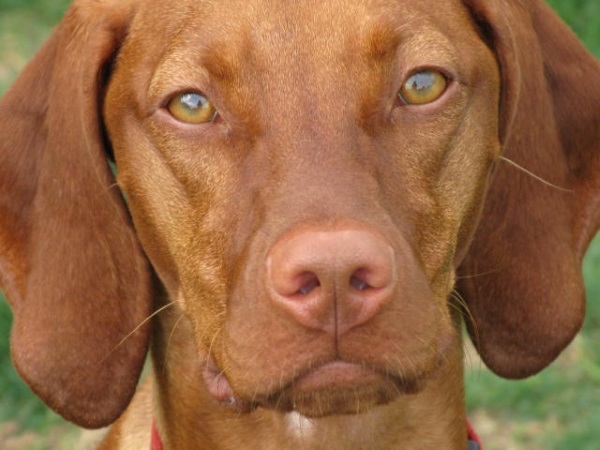
15. Make eye-contact happen between babies and dogs (and other guests!)
It’s important that your dog practice a lot of eye contact with people because babies and toddlers are at the pet’s eye-level. Anyone who visits our home will be asked to make eye contact with Finley first.
16. Plan a safe feeding space for your baby
If you always cuddled with Fido on the couch, don’t use that same spot to feed your newborn. We plan on using a glider in the nursery for most of our newborn’s feedings. We also learned to feed Finley during one of the feeding times to create positive associations.
17. Keep faces apart
Your dog may love licking your newborn’s sweet, milk-dribbled face. But it’s safer not to let the dog and baby faces get too close. There could be too much excitement, the baby could laugh or scream; there are too many unknowns.
18. Recognize your dog’s anxiety cues
A concerned dog has his ears back, looks away and licks his lips. If your dog exhibit these signs, bring him to a safe space away from the baby.
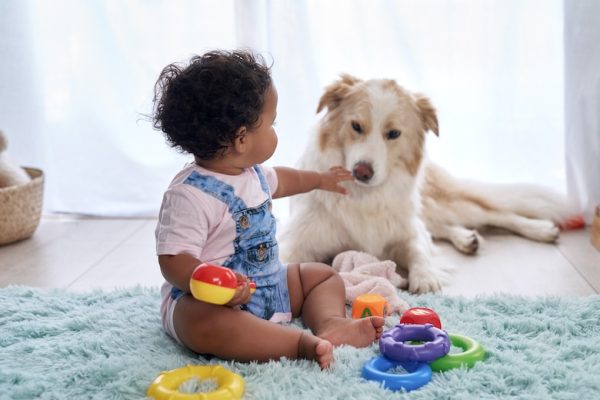
And lastly, don’t forget:
19. One at a time
Don’t ask the same person to watch babies and dogs at the same time. It’s too much at once.
20. Dogs can sense our anxiety
Don’t be afraid of the new situation, but take the proper precautions.
What do you think about dogs and babies? Have you ever brought home a new baby when you already had a dog? How did it go? Tell us your tips and experiences in the comments.
Read more about babies and dogs on Dogster.com:
- 5 Signs Your Dog Is Not Ready for a Baby
- 3 Things to Do Before Introducing Your Dog to a Baby
- Would You Ever Give Up Your Dog Because of Your Baby?
- Do You Ever Worry About Your Dog Being Around a Baby?
- What NOT to Do with Your Baby Around Dogs – Yours or Others
About the author: Whitney C. Harris is a New York-based freelance writer for websites including StrollerTraffic, Birchbox and WhattoExpect.com. A former book and magazine editor, she enjoys running (with Finley), watching movies (also with Finley), and cooking meatless meals (usually with Finley watching close by).

